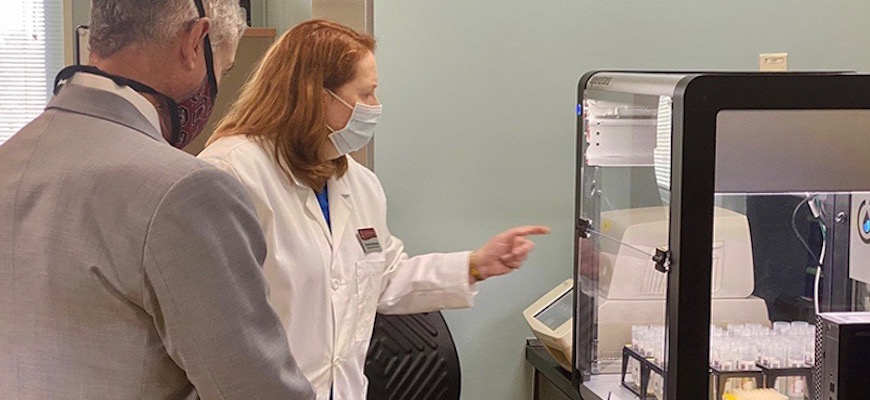
Behind the scenes of SAFE testing
Posted on: October 9, 2020; Updated on: October 9, 2020
By Caleigh McDaniel, stucomm@mailbox.sc.edu
By now most students have heard about the university’s free Saliva Assay Free Expedited (SAFE) testing program, but we wondered what happens behind the scenes. We spoke with Carolyn Banister, who serves as the manager for the College of Pharmacy’s Diagnostic Genomics Lab, to gather insights on what happens to your saliva sample between getting tested for COVID-19 on campus and receiving your results.
When the saliva sample arrives from the testing site at the laboratory in the Coker Life Sciences Building for the state and federally authorized Salivir Detect test, record-keeping is the top priority.
“They're initially barcode scanned to be received into the lab," Banister says. "Then they go into an oven for decontamination. This heats them up to 95 degrees Celsius, which is about 212 degrees Fahrenheit. This does two things. The first thing is that it breaks down the mucus and the second thing is that it will also break apart the virus particles, so they're no longer infectious.
“The outside of the virus is covered with a capsid and the inside is a piece of RNA which is the viral genome.” After decontamination, the RNA is uncovered so the tests can detect the virus.
Next, the sample goes to one of the lab’s liquid handling robots where it is “pipetted into the reaction plate, which then goes into our thermocycler. This will then give us a readout of whether or not there was any virus detected,” says Banister.
For more information about how the robotic liquid handler improves testing capabilities, visit the College of Pharmacy website.
“We also look for a human gene," she says. "This gives us some quality control measures, which is important, because since we are not purifying the RNA, we want to make sure there are no inhibitors in the saliva that cause the tests to not be accurate.”
One reason that a human gene may not be detected is if someone consumes food or beverages within 30 minutes before taking the test.
“We did all sorts of inhibitor studies to see what we could put into saliva that we then couldn’t detect the virus,” Banister says. The researchers tested blood, salt, caffeine, toothpaste, mouthwash and more. One of the things that inhibits the test most critically is salt.
For now, SAFE testing is for UofSC students, faculty and staff, but the goal is to make it available for the surrounding community at a low cost.
Students, Faculty and Staff are strongly encouraged to get tested regularly, even if they don’t have COVID-19 symptoms. Visit the Student Health Services website for more information on testing, including the weekly SAFE testing schedule.
Every week during the month of October, a random sample of students will be invited to participate in saliva-based COVID-19 testing. Upon completion, students will receive a special UofSC T-shirt and will be entered into drawings to win prizes. Participants will receive their test results within 24 hours via their student email.
If you receive an invitation, simply bring your Carolina Card with you to one of the testing sites specified in the email.
Banner Image: Laboratory Manager Carolyn Banister shows university President Bob Caslen how the robotic liquid handler improves saliva-based testing capabilities.
Share this Story! Let friends in your social network know what you are reading about